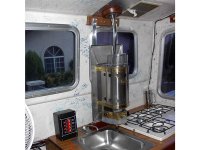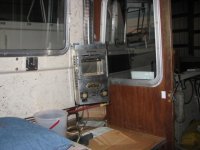Edit: Well that got long once I saw it posted. Please feel free to skip it if you don't want to bother wading through it. It does not contain any world-saving information

*******
I have used propane on a couple of boats and I'm comfortable with it as long as the installation is done properly. If not handled properly, it can be very dangerous. But then so can gasoline. Ironically (as compared to this thread), I avoided carrying gasoline -- just because it was one more volatile fuel to carry, and I didn't have a good option on the boat for properly stowing it.
I only used propane for cooking, as I couldn't carry enough for regular heating (in places where it was not possible to get tanks refilled on a regular basis, and the boat had more interior volume - thus used more fuel to heat - than a C-Dory does).
Even though I liked it, I wouldn't encourage people who aren't comfortable with propane to have it aboard because... why cause yourself worry/angst when there are alternatives available? But for those who are open to it, I think it can be "safe" aboard (I put that in quotation marks because I don't think any volatile fuel can be completely safe aboard, but you can minimize your chances for problems by doing things properly. (C-Dory gas tanks would be an example of that. They are installed properly, vented, grounded, supported, secured, etc.).
I don't see how a propane locker in the cockpit could be a "proper" installation. First, since propane is heaver than air, there is no way for any leaks to drain overboard (the cockpit is not self-draining as I understand it). Second, there is a good chance that any leaks could "drain" into the cabin because the sill is much, much lower than the sides of the cockpit. And third, it does not conform to ABYC guidelines (which are generally practical ones that make sense, not just rules for rules' sake).
Smaller sailboats have the same challenge: Where to put the propane tank? There is an added challenge because, due to heeling, it pretty much needs to be on centerline (otherwise the vent will submerge on one tack, which makes it not a vent). Sometimes it's just not practical to make a locker, and so the boat owner foregos propane.
I'm not completely familiar with the C-Dory 22, but from what I can see there would be a few possible options (but there is no doubt that to add a propane system you would be giving up some space and introducing additional components, which may not be desirable).
One would be either of the lazarettes, making sure they were sealed and had an overboard drain above the waterline. Two might be the motorwell (although that doesn't seem like a great place for a larger tank - I guess it may depend on whether or not you use a swim step and need to climb through it).
Three would be someplace above decks (some sailboats have a niche or open-bottomed box on deck or cabintop). That might be a bit clunky on a CD, although perhaps there is some possibility with one of the slender, tall 6" aluminum tanks - say strapped to a stern pulpit if anyone had one (these tanks should be vertical in use, otherwise one could have one lying down on the cabintop).
So, it seems to me that one would need to want to have propane. I think if someone were in doubt about it, they would resent the space being taken up by the system, and/or be nervous about it all the time.
I will say that I loved propane for full-time cooking (which is all it was used for). Instant on, good heat, easy to lower to a bare simmer, controllable oven for baking, no fumes, no cleaning of burners (had a diesel heater, so I am familiar with that), and an 11# tank would last for months (had two aboard). I think I would also love propane for heating if I were in a position where it made sense to heat with it (either not using the heater full time, or where it was convenient to re-fill the tank - as a furnace will be "thirstier" than a cooker. A heater with a window to see the flame is super cozy aboard (had a window in the diesel heater), and heaters like the P9000 have such a window.
(One note on the introduction of moisture to the cabin: The same heating fuel source that
will introduce moisture in a non-vented situation (i.e. no "chimney") will
not do the same if it is vented (i.e. has a "chimney"). A kerosene or diesel heater that was un-vented would also introduce moisture to the cabin. So a lot depends on the design of the appliance and its installation.)
All that said, I'm not sure I would choose propane for a C-Dory, simply for space reasons. I guess it would depend on my mission/circumstance for the boat. I would have to consider that specifically before choosing.
One more option is CNG. It is like propane but it is not heavier than air, so it does not "sink" and become concentrated on boats/bilges. The main disadvantage of it is that there are relatively few places to get a CNG fill, as opposed to the ubiquitous propane fill stations. However, if you live/boat in an area(s) that do have CNG available, it might be a good option.


